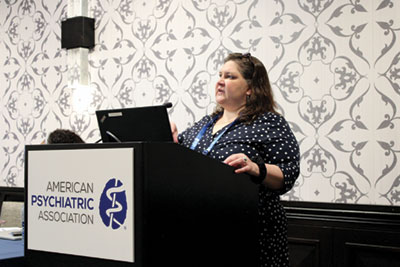Psychiatrists Have Opportunities to Help Build Crisis Systems
Abstract
In the wake of 988’s creation, there are numerous opportunities for psychiatrists to be involved in building out behavioral health crisis services and help ensure their communities have a robust, reliable system that meets patients’ needs.
There are many areas of disagreement in Congress and across the nation right now. But one thing that everyone pretty much agrees on is that it does not make sense for law enforcement officers to be the default first responders to mental health crises, said Margaret Balfour, M.D., Ph.D., an assistant professor of psychiatry at the University of Arizona College of Medicine in Tucson.

“If we want to be involved in this once-in-a-lifetime opportunity to design a whole emergency system for mental health, we can step up and be part of that,” said Margaret Balfour, M.D., Ph.D.
Balfour spoke at APA’s Mental Health Services Conference during the session “988 One Year Later: Where Are We on the Roadmap to the Ideal Crisis System?” She was joined by Billina Shaw, M.D., M.P.H., senior medical advisor for the Center for Mental Health Services at the Substance Abuse and Mental Health Services Administration (SAMHSA). Shaw outlined SAMHSA’s goal of transforming the country’s network of behavioral health crisis systems so it is sustainable and delivers care based on best practices.
There are numerous factors and national initiatives that are creating the right conditions for a movement that could usher in an unprecedented amount of investment in psychiatric crisis care, Balfour said.
The first of those factors was the creation of 988 as the three-digit phone number for the Suicide and Crisis Lifeline. Additionally, there is bipartisan agreement in Congress on the importance of ensuring that patients have access to mental health services, especially when they’re in crisis. Further, the push to reform the nation’s police force also creates an opportunity to change crisis response systems so police are no longer the de facto responders when someone has a mental health crisis. “With all of this going on, there are lots of emerging opportunities for psychiatric leadership,” Balfour said.
Balfour was one of the contributors on the “Roadmap to the Ideal Crisis System” report, published in March 2021 by the Group for the Advancement of Psychiatry and the National Council for Mental Wellbeing. In the report, she said, the authors tried to emphasize the need for systems that support mental health crisis services, with the architects of those systems paying just as much attention to the governance and financing of the system as they do the services themselves.
“One of the things about crisis is that the clinical goals and the fiscal goals are pretty well aligned,” she said. “What I want as a psychiatrist are for my patients to not be in jail, to not be in an emergency room, and to not be locked up in the hospital. If you’re paying for those things, you want the same. It’s a lot less expensive to be doing well in the community than it is to be in jails, emergency rooms, and hospitals.”
She talked about the need for accountability within each behavioral crisis system. Each system will likely have its own version of an accountability entity, whether that’s a regional behavioral health authority, a county department, or some other quasi-governmental agency. “Whatever that accountability entity is, there is going to be need for medical leadership,” she said. Some communities are creating medical director positions, and psychiatrists can even reach out and prompt their communities to create those positions.
Shaw noted several grant programs offered by SAMHSA that communities can use to build out their crisis services. For example, from December 2022 to March 2023, more than 2,000 individuals received mobile crisis services from SAMHSA grantee organizations, which includes 380 confirmed diversions from law enforcement for individuals experiencing a crisis, Shaw said.
The Medical Director Institute of the National Council for Mental Wellbeing created a brief in 2021 titled “Psychiatric Leadership in Crisis Systems: The Role of the Crisis Services Medical Director.” The brief states that, just as emergency medical services are expected to have physician leadership, so too should mental health and substance use crisis systems.
“Populations accessing crisis services typically experience a range of psychiatric symptoms with high acuity, often combined with medical comorbidities, all of which require thorough psychiatric evaluation, medical screening, and triage to promote least-restrictive interventions,” the brief states. “With such complexity comes significant risks for negative outcomes. As such, the role of the [crisis services medical director] within the leadership team is essential in systems seeking to deliver high-quality, safe, and person-centered care.”
“That’s an area of opportunity for us,” Balfour said. “If we want to be involved in this once-in-a-lifetime opportunity to design a whole emergency system for mental health, we can step up and be part of that.” ■



